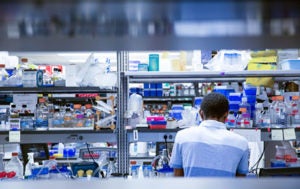Research Areas

Research Areas
Many hormones, neurotransmitters, and secretory proteins are released from cells by exocytosis, which involves complex vesicle trafficking and membrane fusion steps. Investigators at UVa are studying exocytosis and membrane fusion at the cellular and molecular level. Defects in neurotransmitter release lead to multiple neurological and neuro degenerative diseases including epilepsy, Parkinson’s, Alzheimer’s, schizophrenia, and mood disorders.
Faculty Members
Herve Agaisse, Huan Bao, David Cafiso, James Casanova, Bimal Desai, Anne Kenworthy, Ilya Levental, Ling Qi, Lukas Tamm
Bacterial and viral pathogens enter cells by multiple pathways. Investigators study the uptake of bacteria and viral entry into cells that often require a membrane fusion step. Others study the behaviors of proteins on the surface or within pathogens at high molecular resolution.
Faculty Members
James Casanova, Linda Columbus, Alison Criss, Ed Egelman, Andreas Gahlmann, Anne Kenworthy, Lukas Tamm, Jochen Zimmer
Investigators at UVa are studying communication between cells, such as cardiac cells, through gap junction channels. Calcium channels are important in excitable cells including neurons and muscle cells. G protein coupled receptors are the most abundant drug targets, and UVa research seeks a better structural understanding of coupling G protein activation to ligand binding. Channels in the outer membranes of gram-negative bacteria are responsible for nutrient and antibiotic uptake and therefore important drug targets.
Faculty Members
Douglas Bayliss, Bimal Desai, Seham Ebrahim, Ahmad Jomaa, Brant Isakson, Swapnil Sonkusare, Jochen Zimmer
Laboratories at UVa study mechanisms of active transport across membranes. Transporters that are responsible for the uptake and export of sugars, peptides, polysaccharides, vitamins, and drugs are examined structurally and functionally. Questions such as how ATP is generated by dissipating a proton gradient across membranes are being answered.
Faculty Members
How do cells respond to adenosine binding to its receptor? How is calcium influx at the synapse coupled to neurotransmitter release? Are specialized lipids or platforms of proteins and lipids important in these biological circuits? UVa researchers are using multiple techniques to explore these questions that are central to human health.
Faculty Members
Douglas Bayliss, John Bushweller, David Cafiso, Linda Columbus, Douglas DeSimone, Seham Ebrahim, Brant Isakson, Anne Kenworthy, Ilya Levental, Kevin Lynch, Swapnil Sonkusare, Avril Somlyo, Lukas Tamm
